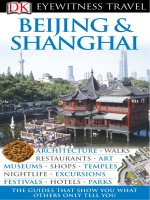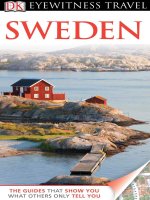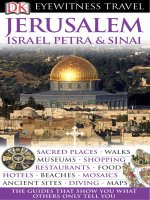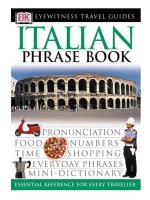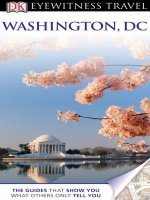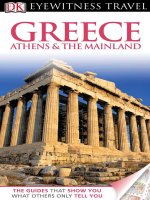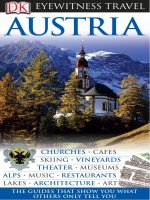eyewitness travel beijing & shanghai
Bạn đang xem bản rút gọn của tài liệu. Xem và tải ngay bản đầy đủ của tài liệu tại đây (27.51 MB, 248 trang )
The guides that show you what
others only tell you
BEIJING &
SHANGHAI
Eyewitness TRAVEL
architecture
•
WALKS
RESTAURANTS
•
Art
MUSEUMS
•
SHOPS
•
temples
NIGHTLIFE
•
excursions
FESTIVALS
•
hotels
•
PARKS
P H@MLDMC@IHD
#().!
.%0!,
"(54!.
"!.',!$%3(
).$)!
-9! !2
4(!),!.$
*/%*"/
0$&"/
0 kilometers
0 miles
400
400
It wasn’t until 1403 when the Emperor Yongle
moved the Ming dynasty capital from Nanjing
(Nanking) to the newly renamed Beijing
(Peking), that the “northern capital” moved
from the fringes of China proper to a role of
central importance. Shanghai, on the other
hand, is an altogether more modern city,
which, since its founding, has been of vital
economic and political importance thanks to
a strategically commanding site controlling
the mouth of the great Yangzi River.
Beijing & Shanghai
BEIJING
See pp56–109
Street Finder maps
pp110–17
3/54(
+/2%!
./24(
+/2%!
-/.'/,)!
2533)!.
&%$%2!4)/.
,!/3
6)%4.!-
#FJKJOH
4IBOHIBJ
4065)
$)*/"4&"
&"45
$)*/"4&"
:& 08
4&"
#0
)"*
SHANGHAI
See pp120–67
Street Finder maps
pp168–73
EYEWITNESS TRAVEL
beijing &
shanghai
beijing &
shanghai
Main contributor
:
peter neville-hadley
Inner Court gateway, the Forbidden City, Beijing
The information in this
DK Eyewitness Travel Guide is checked regularly.
Every effort has been made to ensure that this book is as up-to-date
as possible at the time of going to press. Some details, however,
such as telephone numbers, opening hours, prices, gallery hanging
arrangements and travel information are liable to change. The
publishers cannot accept responsibility for any consequences arising
from the use of this book, nor for any material on third party
websites, and cannot guarantee that any website address in this
book will be a suitable source of travel information. We value the
views and suggestions of our readers very highly. Please write to:
Publisher, DK Eyewitness Travel Guides, Dorling Kindersley,
80 Strand, London, WC2R 0RL.
INTRODUCING
BEIJING AND
SHANGHAI
FOUR GREAT DAYS IN
BEIJING 8
FOUR GREAT DAYS IN
SHANGHAI 10
PUTTING BEIJING AND
SHANGHAI ON THE
MAP 12
A PORTRAIT OF
BEIJING AND
SHANGHAI 14
CONTENTS
A colonial-era lion guarding a
doorway on the Bund, Shanghai
Gateway, Lama Temple, Beijing
PRODUCED BY BRAZIL STREET
PROJECT EDITOR
Andrew Humphreys
ART EDITOR Gadi Farfour
DORLING KINDERSLEY
SENIOR EDITOR Hugh Thompson
DTP DESIGNER Natasha Lu
PICTURE RESEARCHERS Ellen Root
PRODUCTION Linda Dare
CONTRIBUTORS
Peter Neville-Hadley, Donald Bedford, Christopher Knowles
PHOTOGRAPHERS
Chen Chao, Colin Sinclair, Linda Whitwam
ILLUSTRATORS
Gary Cross, Richard Draper, Paul Guest,
Chapel Design & Marketing, John Mullany
Reproduced in Singapore by Colourscan
Printed and bound by Toppan Printing Co., (Hong Kong) Ltd.
First American Edition 2007
07 08 10 9 8 7 6 5 4 3 2 1
Published in the United States by Dorling Kindersley Publishing,
Inc., 375 Hudson Street, New York 10014
Copyright © 2007 Dorling Kindersley Limited, London
A Penguin Company
ALL RIGHTS RESERVED UNDER INTERNATIONAL AND PAN-AMERICAN COPYRIGHT
CONVENTIONS. NO PART OF THIS PUBLICATION MAY BE REPRODUCED, STORED IN
A RETRIEVAL SYSTEM, OR TRANSMITTED IN ANY FORM OR BY ANY MEANS,
ELECTRONIC, MECHANICAL, PHOTOCOPYING, RECORDING OR OTHERWISE WITHOUT
THE PRIOR WRITTEN PERMISSION OF THE COPYRIGHT OWNER.
Published in Great Britain by Dorling Kindersley Limited.
A CATALOGING IN PUBLICATION RECORD IS
AVAILABLE FROM THE LIBRARY OF CONGRESS.
ISSN 1542-1554
ISBN: 978-0-75662-500-9
FLOORS ARE REFERRED TO THROUGHOUT IN ACCORDANCE WITH
US USAGE; IE THE “FIRST FLOOR” IS AT GROUND LEVEL.
Front cover main image: Huxinting Teahouse, Shanghai
SHANGHAI
EXPLORING SHANGHAI
120
SHANGHAI FARTHER
AFIELD 140
SHANGHAI WALKS 154
SHANGHAI
SHOPPING 160
SURVIVAL GUIDE
PRACTICAL
INFORMATION 210
TRAVEL INFORMATION
222
GENERAL INDEX 228
ACKNOWLEDGMENTS
236
PHRASE BOOK 238
BEIJING AND
SHANGHAI THROUGH
THE YEAR 34
THE HISTORY OF
CHINA 38
BEIJING
EXPLORING BEIJING
56
BEIJING FARTHER
AFIELD 86
BEIJING WALKS 96
BEIJING SHOPPING 102
BEIJING
ENTERTAINMENT 106
BEIJING STREET
FINDER 110
The Hall of Prayer of Good
Harvests, centerpiece of the
Temple of Heaven, Beijing
Players and spectators at a game of
mah jong, Hou Hai, Beijing
SHANGHAI
ENTERTAINMENT
164
SHANGHAI STREET
FINDER 168
TRAVELERS’ NEEDS
WHERE TO STAY 176
WHERE TO EAT 188
WHAT TO EAT IN
BEIJING 192
WHAT TO EAT IN
SHANGHAI 194
The Huangpu River and Pudong skyline, Shanghai
BEIJING & SHANGHAI
FOUR GREAT DAYS IN BEIJING 89
FOUR GREAT DAYS IN SHANGHAI 1011
PUTTING BEIJING & SHANGHAI ON
THE MAP 1213
A PORTRAIT OF BEIJING & SHANGHAI 1433
BEIJING & SHANGHAI THROUGH
THE YEAR 3437
THE HISTORY OF CHINA 3853
INTRODUCING BEIJING & SHANGHAI8
R
apidly redeveloping Beijing
changes on an almost
weekly basis, so here are
four days largely dedicated to
giving a flavor of an older China
before it vanishes. Famous sights
like the Temple of Heaven and the
Forbidden City, are safe from the
bulldozers, but traditional hutong
life is certainly under threat, as are
the old open-air markets visited
here, such as Guanyuan and
Panjiayuan. There’s also a day
spent away from the city at the
Great Wall, a must for all visitors
to Beijing. Energetic sightseers
should manage everything on
these itineraries, but this
selection can also be dipped into
for ideas. All walks are reachable by
public transport. Price guides are
for two adults or for a family of
two adults and two children,
excluding meals.
manipulated history of
China through some the
most famous treasures of the
imperial era. Finish the day
by walking to the southern
end of Tian’an Men Square
and ascending the
Qian Men
(see p58), another great city
gate and one of the last
relics of the Ming city walls.
The views back across the
square to the Forbidden City
are the stuff of memories.
FAMILY BEIJING –
INSECTS TO ACROBATS
• To market, for flowers,
birds, fish, and insects
• Let the children run wild
in the park
• Partake in a tea ceremony
• See an acrobatic show
FAMILY OF FOUR
allow ¥800
Morning
Recent years have seen a
revival of Beijing’s traditional
pastimes: hua, niao, yu,
chong – flowers, birds, fish,
and insects. Take a taxi to
the
Guanyuan Market
(see
p103) to see the revived
popularity of all four,
especially the insect vendors
in the alley at the rear. Jump
on the subway at nearby
Fucheng Men and ride four
stops north to Jishuitan. This
is the beginning of the Hou
Hai walk
(see pp100–101),
which you can follow as far
as the restored
Mei Lanfang
Memorial Hall
. At this point
taxi south for lunch at
Lao
Beijing Zhajiang Mian Da
Wang
(see p198).
FOUR GREAT DAYS IN BEIJING
EMPIRE TO REPUBLIC
• The imperial splendor of
the Forbidden City
• Stand on the spot where
modern China began
• Pay your respects to the
embalmed Chairman Mao
TWO ADULTS
allow ¥300
Morning
Start early at
Jing Shan Park
(see p68) at the east side
where the last Ming emperor
hanged himself on a tree
known as the Guilty Sophora.
Climb to the top of the hill
for a spectacular view south
across the roofscape of the
Forbidden City
(see pp62–7).
Just below is the northern
entrance to the palace. It
would be easy to spend a
day here, but for a first taste
rent an audio guide and
travel south along the main
axis, through the emperors’
private quarters, and past the
great halls of audience and
administration. Just a simple
walk through such as this
will still take up much of the
morning. There are snack
restaurants dotted around the
interior, marked on maps.
Afternoon
Leaving the palace by the
main entrance you pass
through the
Tian’an Men
(see
p59); buy a ticket that allows
you to mount the Ming-era
gate and stand where Mao
stood to announce the
formation of the People’s
Republic on October 1, 1949.
The Chairman’s embalmed
body lies in his
mausoleum
(see p58), which is straight
ahead (not open every day),
but first deposit bags to the
south of the
China National
Museum
(see p59).The
museum can be visited
afterwards. It presents a
Practicing
tai ji quan
Tian’an Men, the imposing gate from which the square takes its name
Heroic Socialist sculptures in front
of Mao’s Mausoleum
FOUR GREAT DAYS IN BEIJING 9
Afternoon
From the restaurant it is a
short walk to the magnificent
Temple of Heaven
(see pp74–
7), where you can see locals
enjoying the green spaces,
playing board games, and
exercising. Plus of course
there are the many and
varied historical buildings.
Then back north to the
Purple Vine Teahouse
(see
p108), just outside the
Forbidden City’s west gate,
for tea in a traditional setting.
In the evening, you have
the option of
Beijing Opera
or
traditional acrobatic
performances
in historic
surroundings at either the
Huguang Guildhall or
Zhengyici Theater
(see p107).
Children will definitely
prefer the latter.
jostled for space. If you
haven’t brought your own
packed lunch you can eat at
one of the restaurants at the
site, but they are touristy and
fairly expensive.
Afternoon
Most organized tours head
off to the
Ming Tombs
(see
pp88–9) but these are not
especially compelling unless
you’re really interested in
Ming funerary architecture or
are enjoying your break from
the city. Keep the visit short
then, and have the driver
head back to central Beijing
via the
798 Art District
(see
p85) for a former industrial
compound now busy with
artists’ studios, galleries, and
a handful of suitably cool
cafés in which to observe
Beijing’s boho scene.
DISCOUNT SHOPPING
• Explore Beijing’s biggest
flea market
• Hunt clothing bargains
• Lunch on Chinese dumplings
TWO ADULTS
¥200 plus shopping
Morning
Make an early morning start
– the earlier the better – for
a trip to
Panjiayuan Market
(see p103), best at weekends
but still busy on other days,
too. Here you’ll find just
about any and every kind of
souvenir imaginable at prices
far lower than tourist shops.
From the market take a short
taxi ride to nearby
Hong
Qiao Market
(see p103) to
browse the shoes and
clothes in the main market,
pearls upstairs (beware the
low quality, though), or
everything from PlayStations
to jigsaws and radio-
controlled models in Toy
City, which is in an annexe
to the rear. If you can haul
yourself away, aim to grab
lunch on
Qian Men Dajie
,
which is just a short ride
west and is lined with
restaurants, some specializing
in jiaozi (dumplings).
Afternoon
After dining, stroll to the
Beijing Silk Store
(see p104),
which is just off Qian Men.
From here, take a taxi on to
Bai Nao Hui
(see p104) for
computer accessories and
other electronics, then
further east to
Yaxiu Market
for cheap clothing (see
p104). This is a good place
to finish up as you are now
in the heart of Sanlitun, with
its vast array of bars and
restaurants in which to help
you recover.
The Great Wall – the great unmissable daytrip from Beijing
A seller of bead, coral and stone
necklaces at Hong Qiao Market
ANCIENT ARCHITECTURE
AND MODERN ART
• Walk the Great Wall
• Visit the resting place of
Ming emperors
• View cutting-edge art in a
former factory compound
TWO ADULTS
allow ¥600
Morning
Arrange an early start with
your taxi – hired in advance
– for a trip to the
Great Wall
at Badaling
(see p92). Once
there, head off along the right
hand section of wall for a
longer hike – once you clear
the crowds you can better
enjoy the expansive views
and fresh air without being
Practicing tai ji quan at the Temple
of Heaven
INTRODUCING BEIJING & SHANGHAI10
O
ne of the greatest
pleasures of a visit to
Shanghai lies in
observing the contrast between
the solid civic worthiness of the
foreign buildings on one side of
the Huangpu, and the newly
erected glitzy towers that face them
across the water. The first day out
samples both, while the second
focuses on the city’s excellent
art collections. The third returns
to the contrast of old and
new, but tells the story
through retail, after which,
a break from the bustle with
an expedition out of town to the so-
called “Venice of the East,” the canal
town of Suzhou. Price guides are for
two adults or for a family of two
adults and two children,
excluding meals.
ALL ABOUT ART
• Fabulous artefacts at the
Shanghai Museum
• Lunch on a rooftop terrace
• Visits to working artists’
studios and shops
TWO ADULTS
allow ¥200 plus
meals and show tickets
Morning
The former race course,
now
People’s Park
(subway:
Renmin Park) has become
the center of Shanghai’s
cultural life. Start with the
Shanghai Museum
(see
pp126–9), which is one of
the best in China. How you
divide your visit depends on
your preferences for ancient
artifacts or modern art, but
either way it would be easy
to spend a whole morning
here. Afterwards cross the
park to the
Shanghai Art
Museum
(see p125), housed
in a building that was once
the race course clubhouse.
Lunch upstairs on the terrace
of restaurant
Kathleen’s 5
.
FOUR GREAT DAYS IN SHANGHAI
OLD AND NEW
SHANGHAI
• Colonial architecture on
the Bund
• Lunch on the waterfront
• The skyscrapers of Pudong
• Tunnel rides, express
elevators, and ferry trips
FAMILY OF FOUR
allow ¥1,000
plus meals
Morning
Start at the south of the
Bund
(see pp122–3) around the
Fangbang Zhong Lu junction.
If you get there early enough
you can watch locals perform
their morning exercises of tai
ji quan or sword play on the
promenade. Spend a few
hours wandering the grand
riverfront sweep enjoying the
early 20th-century foreign
architecture and the striking
views across to Pudong.
Some of the buildings can
be entered to view original
murals and period fittings.
Reaching Suzhou Creek,
double back via
Huangpu
Park
for a cheap lunch at
one of numerous waterside
snack restaurants or dine
more luxuriously with views
from the terrace at
M on the
Bund
(see p206).
Afternoon
The well-signposted
Bund
Sightseeing Tunnel
(see
p136) offers a ride beneath
the river in electric gondolas.
You emerge near the base of
the
Oriental Pearl TV Tower
(see p136). Here, you can
either buy a ticket for the
Shanghai History Museum
or visit the
Shanghai Ocean
Aquarium
(see p136) next
door, which is one of the
best of its kind. Afterwards,
it’s a short walk to the
Jinmao Tower
(see p137) and
a stomach-churning elevator
ride to the 88th floor for
some of the most spectacular
views in Shanghai. Once you
have recovered, there’s a
food court in the basement,
and a Starbucks nearby on
the embankment, or stay for
dinner at one of the Grand
Hyatt’s restaurants, all with
staggering views. Walk back
to the riverside and the ferry
terminal and pay ¥2 for a
brief ride across the river
back to where you started
the walk in the morning.
Fan dancer
on the Bund
The gleaming skyscrapers of Pudong, seen from the Bund promenade
Modern sculpture displayed at the
Shanghai Art Museum
FOUR GREAT DAYS IN SHANGHAI 11
Afternoon
For a further dose of modern
Chinese art there’s the nearby
MOCA (Museum of Contem-
porary Art)
(see p124), which
is worth visiting for the
architecture alone. Pass the
strikingly modern
Shanghai
Grand Theater
(see p125) and
check what’s on during your
stay; your hotel can help
make a booking if necessary.
For a terrific view of the
places you have just visited,
cross the road to the
Tomorrow Square building
and take the elevator up to
the reception of the
J.W.
Marriott
(see p186) on the
38th floor. Finally, take a
short taxi ride south to the
Taikang Lu Art Street
(see
p162) for unique creations
from contemporary galleries,
or buy straight from the
artists themselves.
you can walk or take a taxi
to the Old City and the busy
Yu Gardens Bazaar
(see
p130). Most of the flying-
eaved buildings here are of
fairly recent construction but
there is the working City
Temple, the Yu Gardens and
the very picturesque Huxin-
ting Teahouse as well as lots
of shops. Enjoy lunch in one
of the dumpling restaurants
around the teahouse but aim
to be there early as these
places get very busy.
Afternoon
Walk west from the bazaar
among the winding alleyways
of the Old City to get a taste
of the past – old people sitting
outside their homes playing
mah jong while the washing
billows overhead and bicycles
cut through the narrow paths.
Pass old temples, mosques,
and markets, before cutting
north to
Huaihai Zhonglu
,
once the grand Avenue Joffre
and now where the chic
department stores and malls
reside. This isn’t the place
for bargains but it is fun
window-shopping alongside
the Chinese.
Finish the day by taking a
taxi farther west for an early
evening stroll around the
leafy estate of the
Ruijin
Guesthouse
(see p132),
perhaps dropping in for a
drink at
Face
(see p165). This
is the heart of the French
Concession and, after drinks,
there are a great many fine
restaurants nearby.
GARDENS OF SUZHOU
• Enjoy a canal boat ride
• Dine on Suzhou specialties
• Stroll around gardens
designed over generations
TWO ADULTS
allow ¥350.
Morning
Suzhou
(see pp144–9) is
close to Shanghai but an
early start by train or bus is
still recommended (you can
also join an organized tour).
This is one of many canal
towns around Shanghai nick-
named the “Venice of the
East.” That may be some-
thing of an exaggeration, but
most visits do begin with a
ride in the local equivalent
of a gondola, taken from
across the road from the
railway station, to alight at
the
Pan Men Scenic Area
(see
p149). This is where you find
the famous double gate and
climb the Ruiguang Pagoda.
Afternoon
Taxi north to Guanqian Jie
to try Suzhou specialities
for lunch at
Deyue Lou
(see
p207) before tackling your
choice of the gardens for
which Suzhou is famed, such
as the sprawling
Humble
Administrator’s Garden
(see
pp146–7), the quieter and
more intimate
Ou Yuan
(see
p144), or the
Master of the
Nets Garden
, which Chinese
often consider the most
satisfying for its balanced
feng shui.
Tour boats awaiting passengers
for a canal cruise
The garden terrace of Face, part of
the Ruijin Guesthouse complex
Taikang Lu Art Street, the place to
pick up paintings and applied art
ALLEYWAYS AND
AVENUES
• Shop on Nanjing Lu
• Compare the old Chinese
and foreigner quarters
• Drink at a colonial villa
TWO ADULTS
allow ¥500.
Morning
The pedestrianized part of
Nanjing Lu
(Henan Lu to
Xizang Lu) was once known
as the best shopping street
in China. It may no longer
be cutting-edge, but the
goods are better value than
some of Shanghai’s more
fashionable places. From here
12
)BO4IVJ
3(!!.8)
(%.!.
3(!.8)
(%"%)
b
b
b
b
b
b
b
b
b
b
b
b
b
b
b
b
b
b
b
b
b
b
;IPVLPV
4VJ[IPV
9JOZBOH
9JBOZBOH
/BOZBOH
1JOHEJOHTIBO
5POHDIVBO
9JOHUBJ
$IBOH[IJ
)FCJ
9VDIBOH
#BPEJOH
9JBO
8VIBO
%BUPOH
5BJZVBO
4IJKJB[IVBOH
)BOEBO
;IFOH[IPV
:BOBO
-VPZBOH
,BJGFOH
&BTU$IJOB
4FB
1"$*'*$
0$&"/
#BZPG
#FOHBM
4PVUI$IJOB
4FB
8IgAN
(ARBIN
*INAN
8ILINHOT
3HANGHAI
ÃRàMQI
'OLMUD
#HENGDU
,HASA
.ANNING
'UIYANG
.ANCHANG
(ONG+ONG
"EIJING
!&'(!.)34!.
4!*)+)34!.
"(54!.
"!.',!$%3(
32),!.+!
2533)!.
&%$%2!4)/.
-/.'/,)!
./24(
+/2%!
3/54(
+/2%!
+!:!+(34!.
+92'9:34!.
452+-
%.)34
!.
5
:"%+
)34
!.
0!+)34!.
).$)!
-9! !2
,!/3
4(!),!.$
6)%4.!-
4!)7!.
#!-"/$)!
0(),)00).%3
.%0!,
*!0!.
#().!
Beijing sits on a plain 25 miles (40 kilometers) east of
the mountains that once offered protection from the
war-like tribes of the provinces beyond. It is one of
very few capitals not sited on a major river system. By
contrast, Shanghai sits on the banks of the Huangpu
River, on silt carried down in the muddy waters of
the Yangzi and washed up the Huangpu with the tide.
Since rapid development began in the 19th century,
constant dredging has been necessary.
Putting Beijing & Shanghai on the Map
CENTRAL AND EASTERN ASIA
INTRODUCING BEIJING & SHANGHAI
a
a
13
:
F
M
M
P
X
:
B
O
H
[
J
3
J
W
F
S
5BJ)V
:& 084&"
#P)BJ
(%"%)
,)!/.).'
,)!/.).'
3(!.$/.'
!.(5)
4)!.*).
:(%*)!.'
*)!.'35
b
b
b
b
b
b
b
b
b
b
b
b
b
b
b
b
b
b
b
b
b
b
b
b
b
b
b
b
b
b
b
b
b
b
b
b
b
b
b
5POHMJOH
-VBO
%POHUBJ
#PUPV
:BODIFOH
'VZBOH
%F[IPV
4IBPYJOH
"ORJOH
8VIV
5BJ[IPV
2JOIVBOHEBP
%BMJBO
$BOH[IPV
:BOUBJ
8FJGBOH
#JO[IPV
-JBOZVOHBOH
)VBJZJO
+JOJOH
4IBOHRJV
4V[IPV
:BOH[IPV
/BOKJOH
#FOHCV
5BOHTIBO
;JCP
;BP[IVBOH
9V[IPV
/JOHCP
)BOH[IPV
)FGFJ
)VBJOBO
5JBOKJO
2JOHEBP
+JhOBO
4V[IPV
4)"/()"*
#&*+*/(
KEY
Greater Beijing
Greater Shanghai
International airport
Domestic airport
National highway
Major road
Railroad
Provincial border
Great Wall
0 km
0 miles
100
100
PUTTING BEIJING & SHANGHAI ON THE MAP
The modern-day realities are rather
different. Standing in the
shadow of forests of cranes
and partly obscured by
clouds of construction
dust and traffic pollution,
the two cities seem to be
rapidly converging towards
a culturally unspecific
modernity that already sees
Shanghai appearing as an
anonymous urban landscape of the
future in Western science fiction
films. In both cities, boulevards have
been driven through narrow alleys,
ancient courtyard housing is
disappearing beneath shopping
malls and tower blocks, and largely
foreigner-designed complexes of
epic proportions are springing up in
readiness for the forthcoming 2008
Beijing Olympics and 2010 Shanghai
World Expo. Change and
growth are common to
all developing cities, but
in these two great
Chinese metropolises
they are happening much
faster and on a much larger
scale than anywhere else.
Beyond the similarities are
some profound regional differences
and petty rivalries – the citizens of
Beijing and Shanghai are particularly
well-known for needling each other,
each with a sense of pride based on
their home cities’ fundamentally
different histories.
Despite the long periods spent
under foreign rule, Beijingers see
themselves as the truly Chinese
inheritors of a rich imperial culture,
A PORTRAIT OF
BEIJING & SHANGHAI
T
he two cities of Beijing and Shanghai have long loomed large
in the Western imagination, one as the capital of an ancient
and cultured civilization, all temples and ceremony, and the
other as a legendarily louche colonial-era collision of Western and
Eastern cultures, famed as the “Paris of the East.”
Tile relief from the
Forbidden City
Red flags flying next to Qian Men on Tian’an Men Square
Shanghai’s high-rise skyline, a symbol of the city’s booming prosperity
INTRODUCING BEIJING & SHANGHAI16
while Shanghainese hark back to
their city’s foreign-run heyday in the
1920s and 1930s, and see themselves
as the open-minded absorbers and
interpreters of foreign culture to the
rest of China. The Shanghainese
inevitably look east from the Bund
across the river to the gleaming
towers of Pudong, a brand new mini-
Manhattan, where the soaring 88-
story Jin Mao tower is soon to be
surpassed by a 101-story structure
going up just a few yards away.
Pudong is a three-dimensional
advertisement for Shanghai’s booming
economy, designed to increase the
confidence of foreign investors.
Shanghai has the highest average
income per household in China, and
leads the emergence of a middle
class, tiny as a percentage of the
overall population of China, but still
larger than the populations of many a
European nation.
THE POLITICAL CAPITAL
Beijing’s response to Pudong has
been to embark on a concerted
building program of its own, with a
roster of spectacular architecture.
There is the newly christened Central
Business District to either side of the
East Third Ring Road, which features
the flamboyant creations of
internationally famous architects such
as Holland’s Rem Koolhaas.
Elsewhere, Frenchman Paul Andreu’s
startling egg-shaped Grand National
Theater rises immediately west of
Tian’an Men Square, Briton Norman
Foster’s dragon-shaped terminal
increases capacity at the international
airport, and a Swiss-designed Olympic
Stadium in the shape of a giant bird’s
nest is auspiciously located on the
city’s historic main axis, north of the
Forbidden City.
And while Shanghai may be the
country’s commercial center, political
shifts register on Beijing’s seismometer
first. Word-of-mouth from within the
government’s high-security Zhong
Nan Hai compound, the modern
equivalent of the Forbidden City,
typically fuels whispered debate
amongst the city’s inhabitants, who see
themselves as the closest to power.
On a more personal level, Beijing-
ers consider themselves cultured but
lazy, and both admire and resent the
notorious business acumen of their
big-city rivals to the south. The
Early morning exercises along the waterfront promenade of The Bund, Shanghai
A PORTRAIT OF BEIJING & SHANGHAI 17
former consider the latter
jinjinjijiaode or calculating. In return,
the Shanghainese consider Beijingers
to be no less calculating – it’s just that
they hide it behind a smoothly
political exterior. The Shanghainese
are proud of their familiarity with
foreign things, and foreigners on the
street attract less attention there than
they do in Beijing. Quentin
Tarantino’s visit to Beijing for
Kill Bill
caused considerable buzz amongst
the class tuned in to foreign culture.
In contrast, Tom Cruise’s visit to
Shanghai for
Mission: Impossible III
produced only a studied yawn.
Shanghainese often consider
Beijingers, and especially any still
speaking the outmoded language of
politics, as country bumpkins.
CITY TALK
Beijingers often regard Mandarin, the
official national language of China, of
administration, and of a classical
education, as their own dialect. But
the local habit of adding a retroflex
“r” suffix to many words gives their
pronunciation a non-standard growl,
and makes it sound as if they are
rolling the language around their
mouths like wine-tasters, before
spitting it out.
Shanghainese, a language incom-
prehensible to all other Chinese except
some from neighboring Zhejiang and
Jiangsu Provinces (the original homes
of most Shanghai people or their
forebears), often sounds like a series of
ill-suppressed sneezes.
In anticipation of a larger than
usual influx of visitors for
internationally high-profile events,
the government is calling for
increased levels of culture and
civilization, sometimes despairing of
the citizens of both cities. Some
Beijing men have a habit of taking off
their shirts and rolling up their
trousers above the knee in hot
weather, while Shanghainese of both
sexes wear Western-style pajamas in
the street. Campaigns against such
behavior have joined those against
spitting and swearing.
But, however much the government
strives to dress up both populations
and skylines into a uniform readiness
to receive visitors, no one should
regard either city as representing any
more than itself, each with a distinctly
different spirit.
Praying at the Lama Temple, Beijing
Window shopping on Shanghai’s Nanjing Xi Lu
INTRODUCING BEIJING & SHANGHAI18
Language and Script
The Chinese script can be traced back to the oracle
bones of the Shang dynasty (16th–11th centuries BC)
that were inscribed with symbols representing words
and used for divination. Despite changes brought about
by different writing materials, Chinese characters have
remained remarkably consistent. It is said that to read a
newspaper takes knowledge of at least 3,000 characters
but an educated person would be expected to know
over 5,000. Since 1913 the official spoken language
has been Putonghua (Mandarin) but there are many
regional dialects. Although people from different parts
of China may not be able to understand each other,
they can use a shared written script.
A BEAUTIFUL SCRIPT
Writing was elevated to an art form
considered on a par with painting as a
visual aesthetic (see pp26–7). As the process
changed from inscribing bone, brass or stone
to using a brush on silk and paper, a more
fluid writing style became possible.
Seal, in red cinnabar
– this may be a name
seal, or inscribed with
other characters.
Writing materials
were silk, stone, or
paper, which was first
invented around the
2nd century BC.
Cursive script
(cao shu) has strokes
that run into each
other. Fluid and
dynamic, it allows for
great expressiveness.
Oracle bones
display
China’s first examples
of seal script. Questions
were inscribed on the
bones which were then
burnt – the way cracks
divided the inscriptions
was deemed significant.
Bamboo slats
were
used from around
the 5th century BC.
These were tied
together to make the
earliest type of
books. Used for
administrative and
philosophical texts,
the script runs from
top to bottom.
Cang Jie
, minister of the
legendary Yellow Emperor, was
supposedly inspired to invent
the Chinese script one morning
after seeing bird and animal
tracks in the snow.
The Diamond Sutra (AD 868)
is the world’s
first block-printed book to bear a date.
Printing was probably invented about a
century earlier. Movable block printing
was developed in the 11th century but had
less social impact than in Europe because
of the thousands of symbols required.
A PORTRAIT OF BEIJING & SHANGHAI 19
CHINESE CHARACTERS
May be composed of
pictographic, ideographic
and phonetic elements. The
radical (or root), an element
that appears on the left or at
the top of a character, usually
gives a clue as to sense.
Here, in the character for
“good,” pronounced “hao,”
the radical combines with
another meaning element
“child.” The concept,
therefore, is that “woman”
plus “child” equals “good.”
Chinese typewriters
were very difficult to
use. The typist had to find each character in
a tray of thousands. Computers have made
typing Simplified script much easier – the
user types in the Pinyin and gets a sub-
menu of several possible characters.
“Woman”
“Child”
The radical
for “woman”
appears in characters with
“female” associations, such as
“milk,” “wife,” and “sister.”
Combining element
for “child,” is here an
ideographic (meaning)
element. The combining
element may alternatively
be phonetic, giving a clue
for pronunciation of the
character.
The Chinese character
for “Good”
Pinyin is a Romanization
system that was
introduced in 1956. While Pinyin will never
replace the character forms, it is an easier
method for children to start learning the
language and useful for input to computers.
STYLES OF CALLIGRAPHY
Zhuanshu
, or seal script,
was developed during the
Zhou era and used for
engraved inscriptions.
Lishu
, or clerical script,
probably evolved during
the Han era and was used
for stone inscriptions.
Kaishu
, or regular script,
developed from Lishu after
the Han era, is the basis of
modern type.
Cao shu
, or cursive script,
literally grass script, has
strokes that are reduced to
abstract curves or dots.
Xingshu
, or running script,
has strokes that run
together, and is a
semicursive script.
Simplified
script was
introduced in 1956 to make
it easier for peasants to
learn to read.
TG Mosco
w
Chinese Literature
Dating back to the sixth century BC, the earliest Chinese
texts were primarily philosophic, such as the Confucian
Analects and Daoist Daode Jing. History as a literary
genre was not established until the Han period
(206 BC–AD 220) with Sima Qian’s Historical Records:
thereafter each dynasty wrote a history of the preceding
one. As for the novel, a fully fledged Chinese example
did not appear until the Ming period (1368–1644) and
was developed during the Qing dynasty until it was
eventually stifled by Communism. Since the 1980s
Chinese authors have been allowed greater freedom of
expression, although, in 2000, news of exiled writer Gao
Xingjian’s Nobel Prize for Literature was suppressed.
INTRODUCING BEIJING & SHANGHAI20
CLASSICS
Post-Qin dynasty, once Confucianism
had become the state orthodoxy, five
early works were canonized as the Five
Classics: the Book of Changes, Book of
Documents, Book of Songs, Spring and
Autumn Annals and Book of Ritual.
These books were established as the
basis for Chinese education.
TANG POETS
With early beginnings in the Book of Songs and Elegies of
Chu, Chinese poetry reached its height more than twelve
hundred years later in the Tang period (618–907). The
two greatest Tang poets are considered to be Du Fu and
Li Bai. Others include the Buddhist Wang Wei, also 8th-
century, and slightly later Bai Juyi (772–846).
Confucius, author of the Analects,
and his disciples
The scholar class or literati
achieved the
status of government official through
success in the civil service examinations,
based on detailed knowledge of the Classics
and accomplishment in writing.
Du Fu
(AD c.712–770) wrote of
suffering in war, as well as of family
life. His keynote is compassion,
considered a Confucian virtue. His
poems display enormous erudition.
Li Bai
(AD c.701–761) was a
more ebullient figure. A prolific
poet, his favorite subjects were
moon gazing and carousing.
The theme of freedom from
constraint is a Daoist one.
Baoyu
prefers to flirt with
the women rather than obey
his father and study hard to
advance his career.
w
A PORTRAIT OF BEIJING & SHANGHAI 21
EPIC NOVELS
In the Ming era, the novel developed from
folk tales and myths into classics such as
Journey to the West, Romance of the Three
Kingdoms and The Water Margin – a tale
of the heroic fight against corruption. Later,
the Qing novels used a more elevated
language and subtle characterization,
culminating in the romantic novel, Dream
of the Red Chamber. These novels contain
many characters that reoccur in other
cultural contexts from Beijing Opera
to popular television serials and films.
20TH CENTURY
In the early 20th century, fiction writers
and playwrights addressed social
issues in a new realist style. However
Communism demanded revolutionary
themes. After the persecution of
writers during the Cultural
Revolution (see pp50–51),
experimental forms and
styles gradually emerged.
However, the books of
Chinese authors may still
be banned if they are
openly critical of the
government or are
“spiritual pollutants”;
nevertheless pirated
versions are often
widely available.
DREAM OF THE RED CHAMBER
Perhaps the greatest Chinese novel, this
portrays the decline of an aristocratic Qing
household. Infused with a Daoist sense of
transcendence, it focuses on the life and
loves of the idle Baoyu and twelve
perceptively drawn female characters.
Guandi, God of War
,
derives from Guan Yu,
a general of the state
of Shu, portrayed in
Romance of the Three
Kingdoms. This novel
was based on historical
figures from the Three
Kingdoms Era (AD
220–80). A symbol for
justice, honesty, and
integrity, his figurines
are found in temples
throughout China.
Journey to the West
is a comic fantasy
based on the pilgrimage to India of the
Buddhist monk Xuanzang. The late Ming
novel centers on Monkey, one of the monk’s
companions who represents carefree genius,
bravery, and loyalty.
Mo Yan
is a post-
Cultural Revolution
fiction writer. Best
known for his novel
Red Sorghum
(1986), made into a
major film, he writes
in a rich style, often
graphic, fantastic,
and violent.
Lu Xun
, early 20th-century writer of
short stories and novellas, is known as
the father of modern Chinese literature.
His realist, satirical style is indebted to
such writers as Dickens. He is renowned
for his humorous depiction of Ah Q, an
illiterate but enthusiastic peasant, done
down by the forces of convention.

